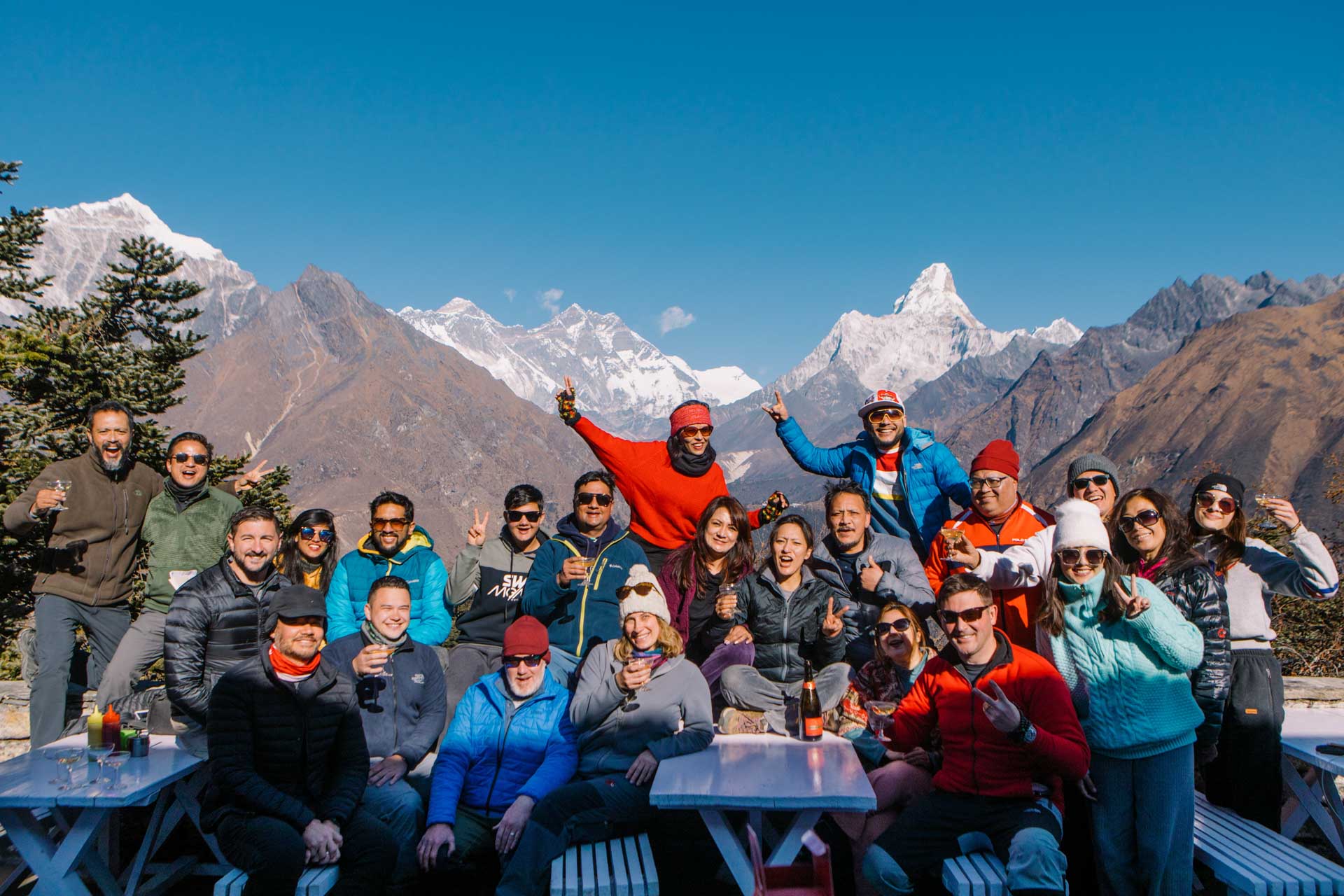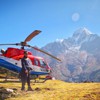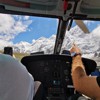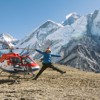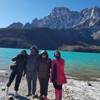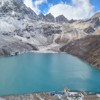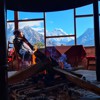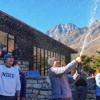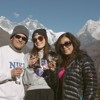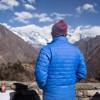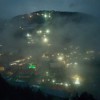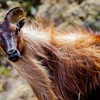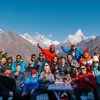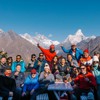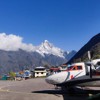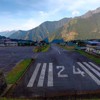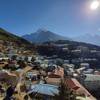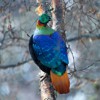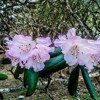New Year at Namche - 4 Days
Unknown
NPR 90,000
Flexible Cancellation Policy & Fair Prices
DATE: 12 April, 2021 - 16 April, 2021 INCLUSIONS Chartered Flight between Kathmandu and Lukla Heli Tour with flyover of EBC with Touchdown at Gokyo Overnight and Champagne Lunch at Hotel Everest View Guided Tour of Lukla, Namche and Khumjung Porter and baggage handling Accommodation with Breakfast
NPR 1,21,500
Flexible Cancellation Policy & Fair Prices
DATE: 12 April, 2021 - 16 April, 2021 INCLUSIONS Chartered Flight between Kathmandu and Lukla Heli Tour with flyover of EBC with Touchdown at Gokyo Overnight and Champagne Lunch at Hotel Everest View Guided Tour of Lukla, Namche and Khumjung Porter and baggage handling Accommodation with Breakfast
USD 1,324
Flexible Cancellation Policy & Fair Prices
DATE: 12 April, 2021 - 16 April, 2021 INCLUSIONS Chartered Flight between Kathmandu and Lukla Heli Tour with flyover of EBC with Touchdown at Gokyo Overnight and Champagne Lunch at Hotel Everest View Guided Tour of Lukla, Namche and Khumjung Porter and baggage handling Accommodation with Breakfast
HIGHLIGHTS
- Celebrate Nepali New Year at the beautiful village of Namche with your loved ones.
- Take a Heli tour to Everest Base Camp, Kalapatthar and Gokyo Lakes.
- Champagne Lunch at the iconic Hotel Everest View and spend a night there.
- Short hikes to the rustic twin villages of Khumjung and Khunde.
- Enjoy a relaxed and easy hikes with stunning mountain views.
QUICK FACTS
- Difficulty LevelEasy
- Total Length108 km
- Highest Altitude5,643 meters
- Elevation ProfileNot available
- Start locationLukla
- Finish locationLukla
- PermitsSagarmatha NP Permit, Khumbu Rural Municipality Permit
- Best SeasonApril 12 - April 16
DAY TO DAY ITINERARY
- Kathmandu
(1,400 m)
- Lukla
(2,850 m)
- Namche Bazaar
(3,460 m)
- Namche Bazaar
(3,460 m)
- Khumjung
(3,780 m)
- Syangboche
(3,750 m)
- Namche Bazaar
(3,460 m)
- Namche Bazaar
(3,460 m)
- Lukla
(2,850 m)
DESCRIPTION
After a successful World's Highest New Year in Dec 2020, HoneyGuide is proud to present to you 'New Year at Namche'. This event is for those who are looking to get more out of their New Year Celebration. Come, lets escape from the maddening crowds into the lap of the Himalayas and for four days immerse ourselves in the mystical experience of the Everest Region.
This tour is priced at NPR 90,000 for Nepalis / NPR 1,00,000 for Indian and Expats and USD 1,129 for all others. Please Call / WhatsApp Ashish @ 9841370673 to book your seat.
DETAILED ITINERARY
DAY 1: 30 Chaitra, 2077 / 12 April, 2021 ~ Chartered flight from Kathmandu to Lukla. ~ Breakfast at Himalaya Lodge ~ Heli Tour with flyover of Everest Base Camp / Kalapatthar and touchdown at the fabulous Gokyo Lakes ~ Drop off at Namche. ~ Check-in to Khumbu Lodge / Hotel Namche. ~ Overnight at Namche.
DAY 2: 31 Chaitra, 2077 / 13 April, 2021 ~ Day tour of Namche Bazaar. ~ New Year Eve at Namche Bazaar.
DAY 3: 1 Baisakh, 2078 / 14 April, 2021 ~ Guided hike to the beautiful Sherpa villages of Khumjung and Khunde. ~ Champagne Lunch at Hotel Everest View. ~ Overnight at Hotel Everest View.
DAY 4: 2 Baisakh, 2078 / 15 April, 2021 ~ Free day to relax at Hotel Everest View. ~ Heli drop off to Lukla. ~ Overnight at Himalaya Lodge.
DAY 5: 3 Baisakh, 2078 / 16 April, 2021 ~ Early morning flight back to Kathmandu.
This tour is priced at NPR 90,000 for Nepalis / NPR 1,21,500 for Indian and Expats and USD 1,324 for all others. Please Call / WhatsApp Ashish @ 9841370673 to book your seat.
The price has the following inclusions / exclusions: INCLUSIONS ~ Chartered flights between Kathmandu and Lukla ~ Heli tour as mentioned in the itinerary. ~ 5 Breakfasts ~ Champagne Lunch and overnight at Hotel Everest View ~ Accommodation on twin-sharing basis at Lukla and Namche. ~ Wages for guides and porters. EXCLUDES ~ Lunch and Dinner ~ Drinks and other beverages ~ Tips for Guides and Porter ~ Airport tax for heli tours ~ Sagarmatha National Park Permit / Khumbu Rural Municipality Permits
HEALTH AND SAFETY ISSUES PRE-EXISTING CONDITIONS If you have any of the following conditions, please have a detailed consultation with your doctor before signing up for this trip: ~ Sickle cell Disease- Increased risk of sickle cell crisis. ~ Pregnancy- First three months puts the fetus at high risk. ~ Pulmonary hypertension- High risk of High Altitude Pulmonary Edema (HAPE) ~ Obesity Hypoventilation Syndrome- High risk of Acute Mountain Sickness, High Altitude Pulmonary Edema (HAPE) and heart failure. ~ Carotid Surgery- Difficulty/Disability to increase airflow in response to low oxygen content. It might be possible to undertake a trek depending upon the kind of surgery. Thorough consultation required. ~ Congenital Heart Problems- High risk of High Altitude Pulmonary Edema (HAPE).
ALTITUDE ILLNESSES Traveling above 3,000 meters poses challenges as the amount of oxygen at that altitude is much lower. To reduce the chances of AMS ~ Drink 4 liters of fluid every day. ORS is highly recommended. ~ Make sure you are warmly clothed at all times. Carry a fleece in your day pack and make use of your windstopper. ~ Limit alcohol consumption throughout the tour. ~ Avoid taking sleeping pills even though you will feel a bit sleepless at high altitude. ~ Stay active during the day. ~ Oximeter and Oxygen supply will be available during the heli tours and also at Namche.
CLOTHING AND EQUIPMENT Few essential items that you should absolutely not forget for this trip are:
- Down Jacket- Mornings and evenings can be pretty chilly. It will make your stay at camp and short excursions that much more comfortable.
- Down Pants- Given that we will not be walking that much, down pants will prepare you for anything mother nature can throw at you.
- Inner Thermals- Both top and bottom will make your stay that much more enjoyable.
- Middle Fleece Layer- A fleece is great for layering with wind/waterproof jacket for walking.
- Wind/Water Jacket- It’s your shell that you can layer with your mid-layers while walking in the trails. Make sure it is breathable and waterproof.
- Buff- It can be used as a neck gaiter, headwear, mask, hairband, and a whole bunch of other ways. One of the best uses, however, is to cover your nose and mouth at high altitudes to hydrate your breath and avoid the cold, dry mountain air. Make sure to keep it rather loose around your nose, though, and your lungs will love you for it.
- Gloves- Make sure it is at least windproof.
- Woolen cap – Perfect in the evenings inside the hotels. Sun Hat/Baseball Hat- Great for protection from the sun when it is still warm enough.
- Trekking Boots- Lightweight, waterproof, ankle support, some toe room, and, most importantly, broken in. Do not compromise on your footwear. It can make or break the experience.
- Sunglasses with straps- Straps are necessary as sunglasses happen to be the one thing that people misplace most often while taking pictures or resting.
- Sunscreen- SPF 30-50 will be good enough. There is little point in going over that. However, make sure it is rated UVA in addition to UVB.
- Lip Balm- Moisturizing and SPF 30 necessary.
- Paracetamol 300 mg- 20 tablets. For mild headaches.
- Throat lozenges- 20. For cough and sore throat. It can be used preventively against the cold, dry mountain air.
- Acetazolamide (Diamox) 250 mg – 20 tablets. To aid acclimatization and AMS treatment.
- Antacids
Relevant Links: Best Time and Weather / Packing List / Accommodation / Lukla Flight / WiFi, Mobile Network, and Electricity / Food and Drinks / Sherpa Food / Wildlife / Flowers / Birds
FAQS
Traveling to the mountains poses some inherent risks. As such, the best strategy is to prepare for the worst and then hope for the best.
PRE-EXISTING CONDITIONS
The first thing to keep in mind is to see if you have pre-existing conditions that could cause complications at high altitudes. Specifically, suppose you have sickle cell disease, pulmonary hypertension, obesity hypoventilation syndrome, or congenital heart problems. In that case, we highly recommend you consult with a qualified physician before planning a trip to the mountains. Read more.
ALTITUDE-ILLNESS
Given the low amount of oxygen at high altitudes, a sensible ascent is essential to give your body the time to acclimate to the thin air. Failure to do so can lead to your lungs or brain filling up with water leading to death in some cases. The key is not to climb more than 500 meters in one day once you pass the 2,500 meters mark. Read more.
ENVIRONMENTAL HAZARDS
Given the extreme weather in the high mountains, proper gear and regimen must have a safe and comfortable tour. The three most important things that you have to prepare for are cold, snow, and radiation. As such, invest in the right sunglasses, sunscreen, boots, and clothing. Read more.
TRAVEL INSURANCE
We highly recommend everyone get travel insurance covering high altitude evacuation before leaving on a trek to the high mountains. Global Rescue and World Nomads are both highly recommended. For Nepali travelers, please note that insurance that covers helicopter rescue is not available as of now. As such, please be careful while planning your tour and only work with companies that can provide timely evacuation service if needed.
RESCUE AND EMERGENCY
As health facilities are limited in the mountains, a helicopter's evacuation is usually the only option during an emergency. As such, the right insurance provider is essential. If you are not buying insurance for some reason, please ensure that there is someone in Kathmandu who can coordinate payments for a helicopter rescue. Here are some other contacts that might come in handy during an emergency. If you still have questions, please feel free to call / whatsapp us at +977-9801916215 or email Ashish at nectar@honeyguideapps.com
HOW DO I MAKE A PAYMENT?
To confirm your tour, you will have to make complete payment either through one of your integrated payment gateways or transfer the funds to the following bank accounts:
For Nepali citizens:
Account Name:: HoneyGuide Pvt. Ltd. Beneficiary Bank: Himalayan Bank, Patan Branch Account Number: 00606903770018For Indian Citizens:
For USD transfers
Account Name: HoneyGuide Apps, Inc. Bank Name: Silicon Valley Bank Account Number: 3302225311 Swift Code: SVBKUS6S ABA Routing Number: 121140399BOOKING A TOUR
Deposit Required for Reservation: 50 percent of total tour cost Deadline for Full Payment: 2 weeks before the tour begins
CHANGING A TOUR
Two weeks before tour date: No extra charge 1 to 2 weeks before tour date: 10% additional charge Two days to 1 week between tour date: 20% additional charge Within two days of tour date: Above 30% (variable)
CANCELLING A TOUR
Two weeks before tour date: No charge (transaction charges may apply) One to two weeks before tour date: 20% Cancellation Charge Two days to one week between tour date: 50% Cancellation Charge Within two days of tour date: No Refund.
DELAYS AND CHANGES DURING THE TOUR
In case of flight delays/cancellations due to bad weather or unforeseen circumstances, HoneyGuide will change the dates at no additional costs. However, any extra cost incurred, including but not limited to accommodation and food, will be the responsibility of the traveler.
In case of changes due to the trekker's health issues, HoneyGuide will make all the changes without any additional cost. However, any extra charge because of the changes will be the responsibility of the traveler.
While Nepal's mountains see six seasons, the best period to go to the mountains is from March-May and September-December. However, every season has its quirk, just like people. So keep reading to find your match.
For those going to Everest Region, do check out the Best time to go to Everest post.
January/February (Winter)
January/February is a good time for trekkers willing to brave the cold and snow for empty trails, fantastic mountain views, and wildlife sightings.
March/April (Spring)
This is a period that offers a little bit of everything: a little bit of mountain view, a little bit of warm weather, a little bit of flowers, a little bit of crowd, and a whole lot of fun.
May/June (Summer)
This is the best time for those into nature. The flowers are quite something this time of the year, and the bird activity is fantastic. The monsoon hasn't started, and as such, mornings are still clear with beautiful mountain views.
July/August (Monsoon)
Only for hardcore trekkers who are willing to put up with the elements for an authentic cultural experience and high altitude flowers. Also, flight disruptions are very likely, and chances of mountain views are close to zero.
September/October (Fall)
This period is everyone's darling, and the trails are as crowded as they can be. The mountain views are something to write home about, and the temperature is just perfect.
November/December (Pre-Winter)
Another popular period among trekkers and the driest two months in the calendar. Indeed it has gotten a bit nippy during the mornings and evenings, but it is still manageable. Count on a lot of sunshine and crystal clear mountain views.
